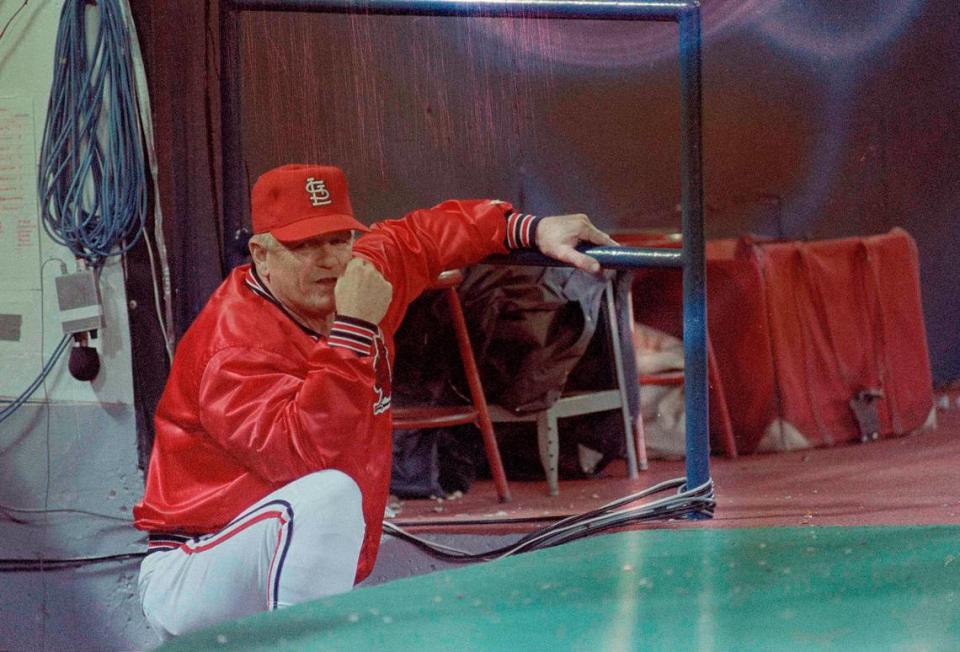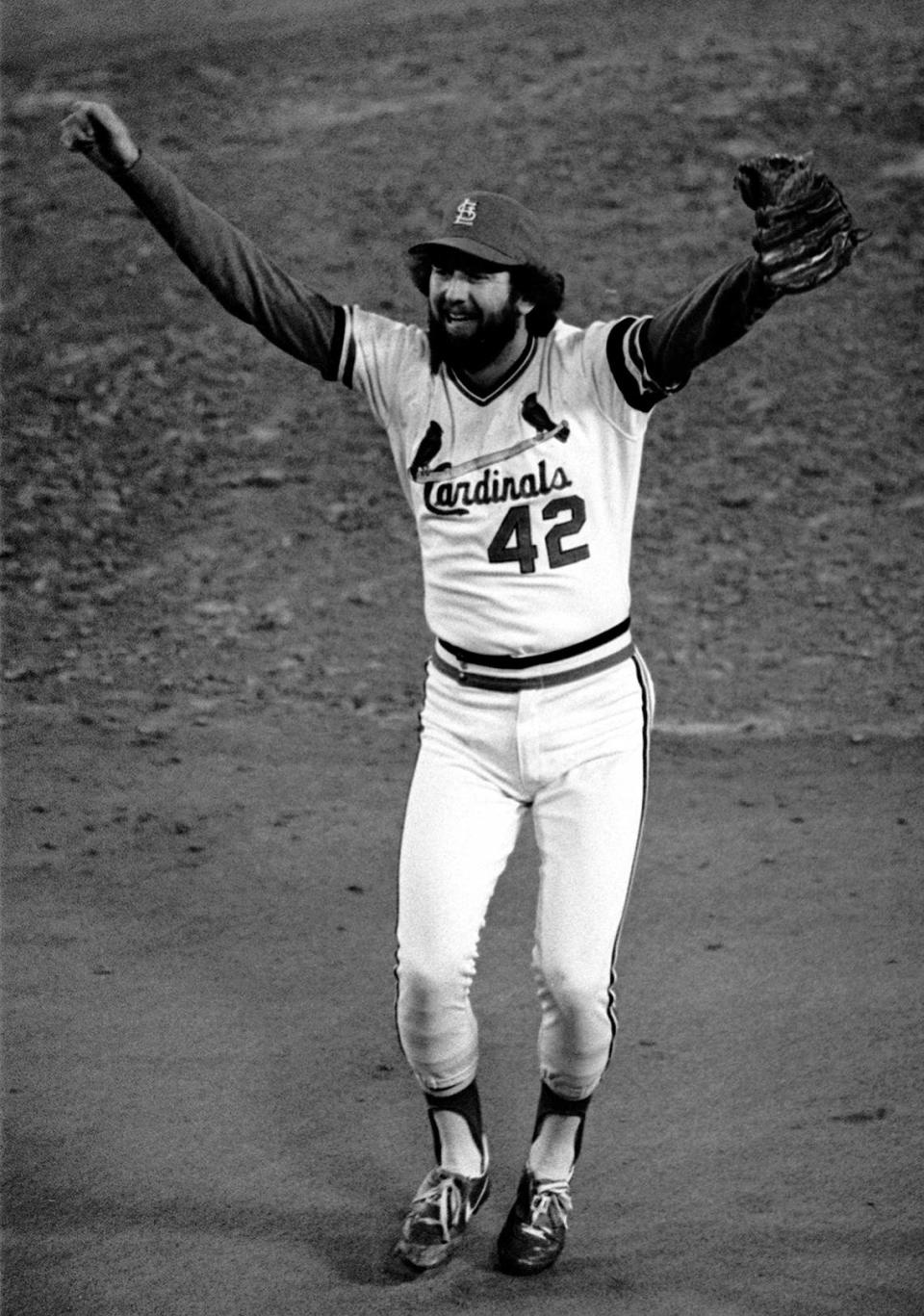Whitey wanted a ‘door slammer’ for his championship Cardinals. Bruce Sutter was his pick.
The blueprint for Whitey Herzog’s Redbird reboot in the off season of 1980 included finding a dominant pitcher reserved exclusively for high-leverage, late-game situations.
A “door-slammer” is how he termed it.
For four days that December, he had the two best closers in the business. It was during that crazy week when Herzog — who had been hired the previous June as both manager and general manager — orchestrated four transactions that sent 22 players either coming or going.
Rollie Fingers did both.
On Monday, Herzog shipped young catcher Terry Kennedy and some spare parts to the San Diego Pardres in exchange for Fingers, Gene Tenace and more extras. Fingers was a durable reliever who had won three World Series with the Oakland A’s, had been a five-time All-Star (seven times in all), and had twice led his league in saves.
Then on Tuesday, Herzog sent top prospect Leon Durham and popular third baseman Ken Reitz to the Chicago Cubs for Bruce Sutter, who was four years younger than Fingers and had won the NL Cy Young Award a year earlier with an (almost) unheard of 37 saves.
Fingers was a better-than-adequate Plan B, but Sutter — who died Thursday at the age of 69 after a brief bout with cancer — was the guy Herzog wanted all along.
He didn’t think two premier closers could cohabitate in the same bullpen. So, on Friday, he shipped Fingers, catcher Ted Simmons and starting pitcher Pete Vukovich to Milwaukee in a deal that did more for the Brewers than the Cardinals.
When Sutter arrived in St. Louis, he was still just 28 but, in addition to the Cy Young, was already a four-time All-Star and two-time Rolaids Relief Man of the Year.
Batters would drill themselves into the ground trying to hit his split-fingered fastball, a pitch he learned from Cubs minor-league instructor Fred Martin when injury had taken some velocity off Sutter’s regular fastball. A hybrid forkball, the pitch came in hard, but dropped at home plate as if pulled to the ground by a magnet.
To that point in his career, Sutter averaged better than a strikeout per inning, but his signature pitch also coaxed a lot of ground balls, which was well suited for the sure-handed infield Herzog had assembled. In his first season, the strike-shortened 1981, Sutter saved a National League-best 25 games.
For the record, Fingers led the AL with 28 and won both the Cy Young and MVP awards that year and, in ‘82, saved 29 more before a shoulder injury ended his season. But Simmons drove in 97 runs, Vukovich won 18 games and the Cy Young, and the Brewers captured the American League title.

It’s a good thing that Herzog’s wheeling and dealing produced its own pennant or that trade with the Brewers might have gone down as an all-time stinker.
For his part, Sutter contributed 36 saves with a 2.90 ERA and was the door-slammer in three World Series games, including his Game 2 win. His triumphant fist pump after striking out Gorman Thomas to clinch the Game 7 victory has become an indelible image in the franchise’s collection of great moments.
Individually, 1984 was Sutter’s best season. The shaggy-bearded right-hander from Mount Joy, Pennsylvania, saved a then-record 45 games with a 1.54 ERA. Sutter either saved or won 46 percent of the Cardinals’ 82 victories that season, which was the last of his contract with the Cardinals.
Having given up the GM’s role, Herzog lobbied his bosses at the brewery to move quickly to get Sutter resigned. But cable-TV magnate Ted Turner and his Atlanta Braves swooped in with a contract that may go down as one of the worst in baseball history (or, from Sutter’s perspective, the best).
The Braves agreed to pay Sutter $750,000 each of six years as a player, then $1.12 million annually for 30 years thereafter. Sutter received his final payment worth, in principal and interest, $9.1 million in 2021.

A disappointed Herzog predicted at the time that he’d be “25 games dumber” without Sutter in his bullpen.
Instead, he won 100 games and his second NL championship as the Cardinals’ skipper in 1985. Sutter injured his shoulder midway through that season and, over the remaining four years of his career, would save just 40 more games.
But Herzog and Sutter had changed the value of the save and the way late-inning stoppers would be used. Sutter’s 37 stops for the Cubs in 1979 fell just one shy of the old record set by the Detroit Tigers’ John Hiller in ‘73. That mark has since been matched or bettered 259 times.
A key distinction, however, is that Sutter often had to earn his saves with two or more innings of work as opposed to the current trend of one or less. Sutter averaged 107 innings over 12 seasons. By contrast, Mariano Rivera, the all-time saves leader and baseball’s only unanimously-elected Hall of Famer, averaged 78.
Sutter shares the 28th spot on the career saves list with Jason Isringhausen and was inducted into the National Baseball Hall of Fame in 2006.


